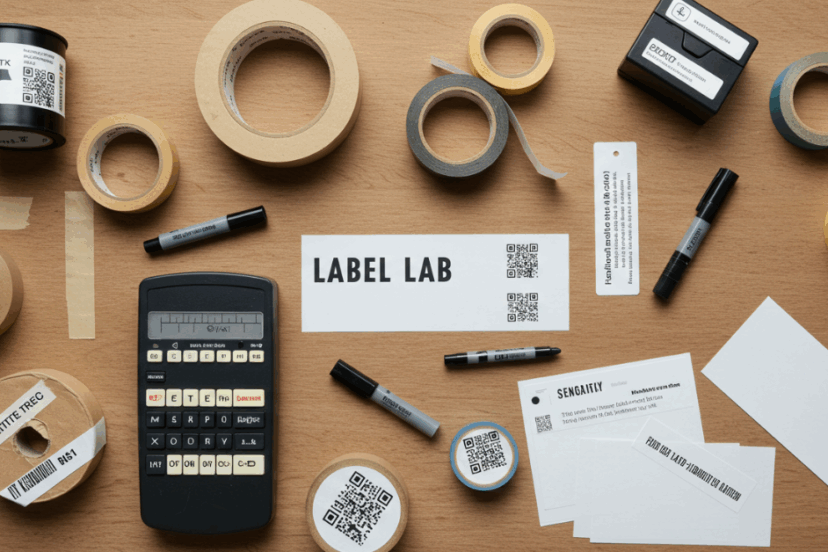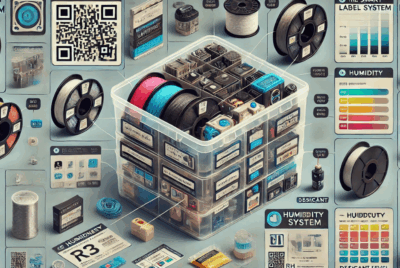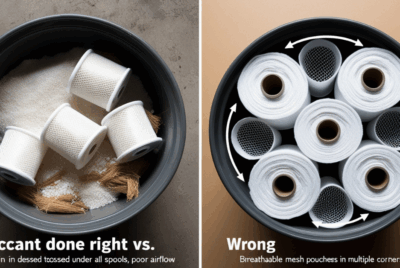What are the top label templates and tools for organizing filament storage?
1. Get Your Spools Together
If you’re like most makers, your filament collection has outgrown your memory.
Which spool is PLA? Which was dried last month? Which one jams at 210°C?
That’s where label templates and tools come in.
A simple label can save hours of troubleshooting, reprinting, and guesswork.
2. Why Filament Labeling Tools Matter
Organized labeling helps you:
✅ Track drying and RH status
✅ Prevent material mix-ups
✅ Reuse leftover spools with confidence
✅ Stay efficient across multiple printers or storage bins
In short: labels = fewer headaches.
3. What Makes a Good Filament Label?
A solid label should include:
- 🎯 Material type (e.g., PLA, PETG, ABS)
- 🎨 Color name or code
- 🏷️ Brand + line (e.g., eSUN PLA+, Hatchbox ABS)
- 📅 Date dried or opened
- 📈 Recommended temps (hotend + bed)
- 📋 Notes on issues (if any)
- 🔁 Reuse/dry cycle tracker
Whether handwritten or digital—clarity is key.
4. Key Information to Include on Every Label
| Field | Why It’s Important |
|---|---|
| Filament type | Prevent wrong settings |
| Brand & color | Identify material quirks |
| Dry date | Moisture tracking |
| Last used on | Printing context |
| Notes | Help troubleshoot later |
| RH reading | Optional, but powerful |
| Desiccant check date | Maintenance log |
5. Best Pre-Made Label Templates for Filament Spools
| Source | Format | Highlights |
|---|---|---|
| 3D Print Trend (COMING SOON) | Printable PDF | Standard + dry log layout |
| Thingiverse | STL + PDF | Print tags or download cards |
| Etsy | Paid digital | Clean, editable, often stylized |
| Maker forums | Excel/Google Sheets | Spreadsheet tracking |
| Printables.com | 3D printable + writable | Snap-on or tie-on labels |
💡 Many templates are editable in Word, Canva, or Google Docs.
6. Printable Label Template Ideas (Free and Paid)
🧾 Free ideas:
- Spool ID Card – PLA | Overture | White | Dried: 3/12
- Dry Box Tag – RH: 23% | Silica recharged: 4/1 | Next check: 4/15
- QR Log Label – Scan to view filament history in Google Sheets
🛒 Paid ideas worth checking:
- Canva templates for branded layouts
- Etsy bundles for professional-looking storage systems
7. Best Labeling Tools (Pens, Tape, Label Makers)
| Tool | Best Use |
|---|---|
| Sharpie fine tip | Spool + masking tape |
| Painter’s tape | Easy to remove |
| Label maker (Brother/Dymo) | Clean, professional labels |
| Dry-erase tags | Temporary or experimental prints |
| Velcro tags / luggage labels | Dry boxes, bins, multi-spool setups |
🛠 Bonus: Use magnetic labels on metal racks or drawers.
8. Recommended Software and Apps for Digital Labeling
| App/Tool | What It Does |
|---|---|
| Google Sheets | Custom filament log + QR code generation |
| Canva | Design printable labels |
| Airtable | Cloud-based inventory tracker |
| Filamentory App (Android) | Track by weight, color, and notes |
| 3DPrinterOS | Full cloud tracking of printer + filament data |
Link physical labels to digital logs for max control.
9. Using QR Codes to Link to Filament Logs
💡 Print QR codes that link to:
- Filament inventory spreadsheets
- Drying history
- Print success logs
- Manufacturer datasheets
Use free tools like QRCode Monkey to generate scannable links.
Stick them right on the spool or storage bin!
10. How to Organize by Label Color or Tag Style
Try using:
- 🟥 Red = Dry Soon
- 🟨 Yellow = Mid-use
- 🟩 Green = Print Ready
- 🔷 Blue = Specialty material
- 🟪 Purple = Print-only (no re-dry)
Or color-code by material type or printer assignment.
11. Labeling Tips for Vacuum-Sealed Filament
- Use tape outside the bag
- Include a label inside the seal for backup
- Write drying date and material clearly
- Include RH card + silica pack in every bag
Don’t forget to mark: “DO NOT OPEN UNTIL READY TO USE”
12. Dry Box & Container Labeling Templates
Useful label types:
- ✅ Container type + bin ID (e.g., “Bin 3 – Active PLA”)
- 💧 RH range (e.g., 18–25%)
- 🔁 Desiccant recharge date
- 📦 Spools included (color-coded or listed)
Stick on the outside, under the lid, or inside a dry box door.
13. Labeling Multi-Spool Bins the Right Way
Each bin should have:
- A master bin label
- Individual spool labels
- A shared RH tracker
- Grouped materials (all PLA, all PETG, etc.)
- Desiccant logs (e.g., “Refreshed 4/1”)
Don’t label like a mystery box. Label like a pro shop.
14. Common Mistakes When Labeling Filament
❌ Using pencil (fades or smears)
❌ Forgetting to label drying dates
❌ Mixing hand-written + printed labels (confusing format)
❌ No RH or desiccant tracking
❌ Leaving QR codes unlinked or broken
Keep it clear, consistent, and easy to update.
15. Final Thoughts: Stay Labeled, Stay Efficient
Every spool of filament has a story—labeling lets you tell it.
✅ Use printable templates
✅ Stick to one system
✅ Include drying/RH/desiccant dates
✅ Level up with QR codes and digital logs
Because the best filament setup isn’t just dry—it’s organized, trackable, and ready to roll.
❓FAQs
- Where can I find free filament label templates?
Thingiverse, Printables.com, Reddit, and soon—your very own download from 3DPrintTrend.com! - Should I label both the spool and the container?
Yes—always label the spool. The container should have a summary label if it holds multiple spools. - What’s the best tape for temporary labels?
Painter’s tape—it sticks well but peels off clean without residue. - How often should I update labels?
Any time you dry a spool, open a new one, or change RH/desiccant conditions. - Do QR codes really help?
Absolutely! They’re great for linking to drying logs, slicing profiles, or print success notes.




